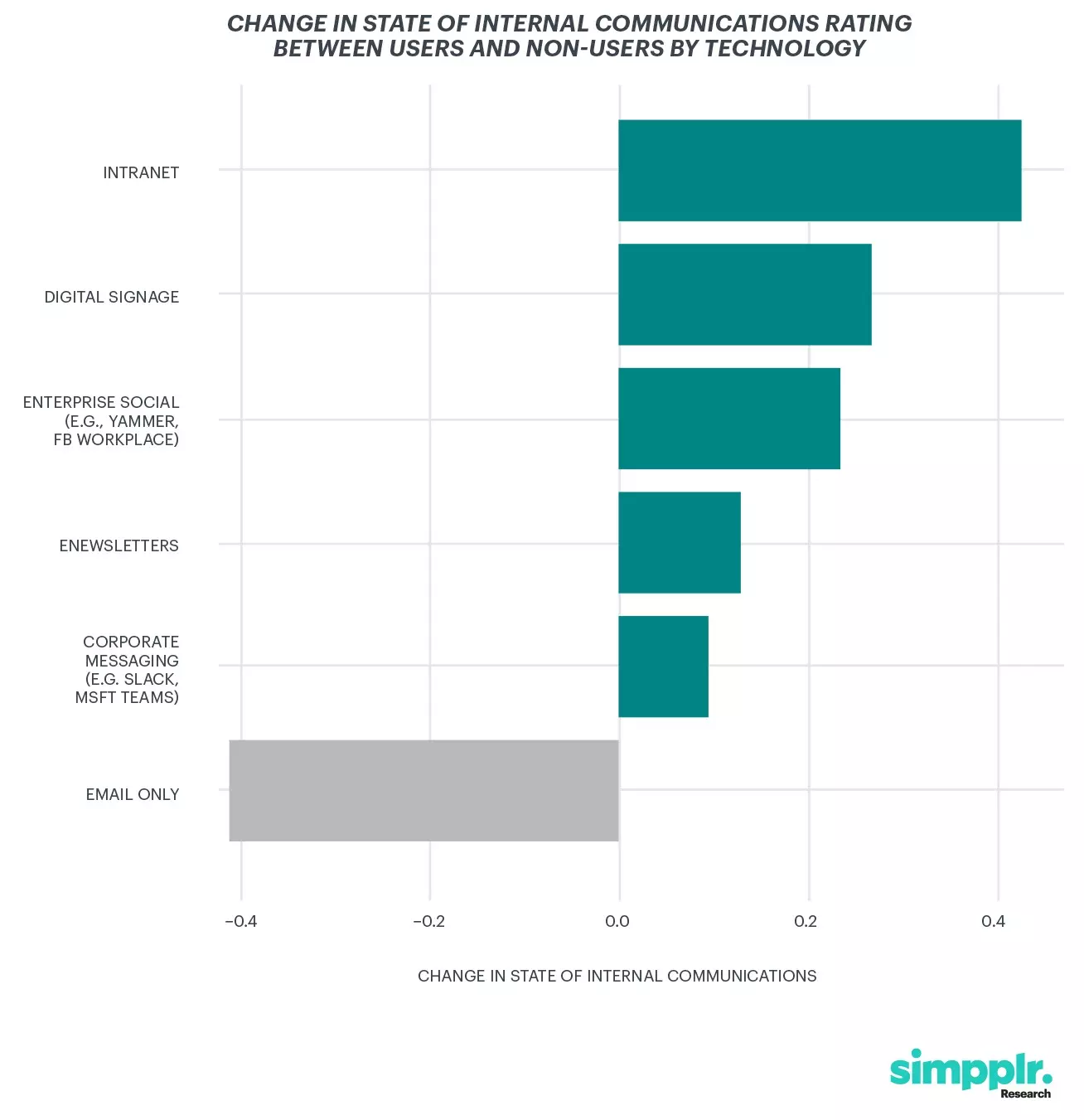Simpplr Research just concluded our latest report, State of Internal Communications 2019. The survey gauges the state of the internal communications (IC) profession and seeks to find insights on how to improve it. This week, Simpplr Research shares insights on the most critical internal communications technology.
Chart of the Week: What’s the most important internal communications technology?

Data Analysis: This chart shows the effect of each internal communications technology on the overall state (quality) of internal communications within organizations. This analysis follows a “differences-in-differences” approach. The magnitude of the bars above was generated by taking the average scores (on a 5-point scale) of organizations that do not regularly use technology and subtracting from the average scores of organizations that usually use technology. Data was obtained from Simpplr Research’s State of Internal Communications 2019 Survey, with the sample size greater than 400. The data shows that regular intranet usage was associated with the most substantial change in the average state of internal communications ratings. The magnitude of the intranet change was ~0.45, almost double the change associated with regular usage of the next higher technology, digital signage. Digital signage was associated with a change of 0.25 in average internal communications ratings. A few technologies did not have a significant effect on internal communications. For example, eNewsletters and corporate messaging technologies both had positive results, but the magnitude of regular usage of these technologies on internal communications quality was minimal, with less valued at 0.15 each. These differences were not significant at the alpha = 0.05 level after conducting a heteroskedasticity consistent two-sided t-test of means. Statistically, it’s difficult to infer that usage of eNewsletters or corporate messaging has a significant impact on internal communication quality within an organization. Companies that only used email (“email only”) had lower internal communications technology than companies that used email along with any other technology. The magnitude of this difference was striking, with companies that only used email rating almost 0.45 points lower on the state of internal communications scale than those that used any other technology.
Communications tools ranked by internal communications impact
This week’s chart measures the changes in the state of internal communications ratings between practitioners by the type of technology used in their IC programs. At the top of the list, intranets are widely used by IC practitioners that have on average, a better overall state of internal communications. The most significant positive impact on an IC is intranet adoption, followed by digital signage and an enterprise communications tool (such as Yammer). The last two technologies with the least significant impact are eNewsletters, followed by corporate messaging tools (such as Slack). However, email is the most widely-used tool but has a significant negative impact on an organization’s state of internal communications.
Intranets positively impact internal communications
The results are surprising to an extent. Intranets have the most significant positive impact (out of the technologies surveyed) on IC because intranets are purpose-built for internal communications. Purposeful intranets house critical information that is applicable and useful for all employees. Some modern intranets have the capabilities to auto-archive stale and unused content, preventing your intranet from becoming a content dumping ground. That way, your intranet remains as the single source of truth and employees only see what is current. Other modern capabilities that improve internal communications include:
- Intuitive user experience
- Personalized and relevant content
- Tailored content based on role, location, department
- Integrations with digital workplace apps
- Intranet access across mobile devices
Intranets, when designed purposefully, have the potential to connect, align, and engage your entire workforce and improve the overall state of your internal communications.
Email is the least effective in internal communications
Aside from intranets, other technologies are also methods of communication, but they’re built with a distinct purpose. For example, Yammer is a communications tool explicitly created for chat. If we think about email the same way, it’s not surprising that it’s the least effective in IC. But what’s shocking is the degree of negative impact on the overall state of IC. If we take a step back and understand how employees use email, it becomes less of a shock factor. Emails are widely used for various purposes, so it does not limit its usage for important information. Think about how many unread emails are in your inbox. You receive spam; people send emails just for the sake of replying, and so on. So to use email as a vehicle for internal communications becomes ineffective because your inbox gets cluttered, and everything becomes noise.
Download the State of Internal Communications Report 2019
To learn more about the impact of technologies used in internal communications, download the State of Internal Communications report here.

















